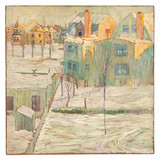John R. Grabach determined to be an artist early on and took lessons from a local artist in New Jersey, Albert Dick, and joined the Newark Sketch Club before enrolling at the Art Students League in New York. Supporting himself as a machinist and then a designer of silverware, Grabach spent his free time painting. He began exhibiting publicly in 1913 at the National Academy of Design and in important annuals. In 1915 he returned from Massachusetts, where he had lived for three years, to settle permanently in New Jersey. In 1922 he and eleven other artists formed The Dialis for the purpose of exhibiting together.
Inspired by Ash Can school artists, Grabach became fascinated with the urban landscape. The decorative, dynamic character of his Wash Day series of the mid-1920s became the hallmark of his brand of urban realism. Toward the end of the decade his lighthearted treatment changed as he became more concerned with social conditions, and consequently during the Great Depression his urban images developed a stronger, satirical tone, and the figures were made larger and dominated the scene. At this time Grabach supported himself by working as a freelance illustrator and a teacher of life drawing at the Newark School of Fine and Industrial Art. Despite recognition and awards, Grabach began retreating from public attention and the mainstream art world. Thus he was all but forgotten, despite the fact that he continued to teach and paint, adopting in the 1940s a dark, Munich-inspired palette and brushwork.
BIBLIOGRAPHY
Henry Gasser, "The Career of John R. Grabach," American Artist 28 (March 1964): 38-43, 62-63 § Washington, D.C., Smithsonian Institution, National Collection of Fine Arts, John R. Grabach: Seventy Years an Artist, exh. cat., 1980, published by Smithsonian Institution Press, text by Virginia M. Mecklenburg, with chronology, list of exhibitions, bibliography § New York, Graham Galleries, John R. Grabach, 1880-1981: Urban America between the Wars, exh. cat., 1981, with introduction by Harry Rand.

